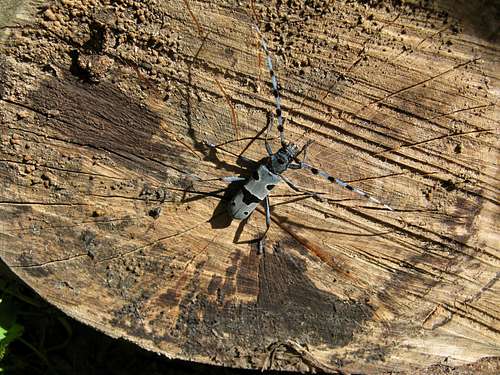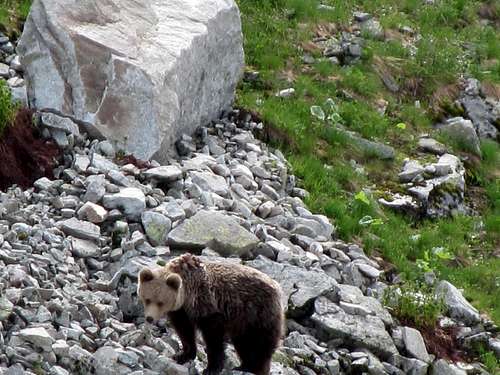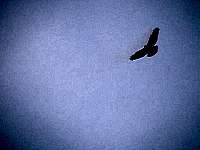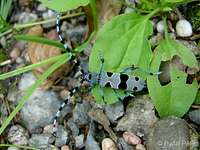|
|
List |
|---|---|
|
|
Overview
This list is open to nature lovers, who can contribute with their own wildlife experiences in the Carpathians. Feel free to enrich it. It is a common interest.The Carpathians are famous for its greatest population of carnivores in Europe. As the last area in continental Europe to support viable populations of large carnivores, harbouring perhaps 10 to 20 times more individuals than the Alps, the significance of this can hardly be overestimated. Over 8 000 brown bears (Ursus arctos), 4 000 wolves (Canis lupus), 3 000 lynx (Lynx lynx) and numerous wildcats still roam the Carpathian region. On a continent, where more than 40% of mammals are under threat of extinction, the population of carnivores in the Carpathians are of immeasurable value.
Mammals
Brown bear Ursus arctos|
Female bear with two cubs in the Tatras Temné Smrečiny and solitary bear in Tichá valley - by LukZem |
It is the most widespread bear in the world. The Carpathian population is estimated to be about 8 000 individuals being the second largest in Europe. The population of brown bear in Romania is flourishing and reach the highest density in the old continent (about 6 000 individuals). About 800 brown bears are reported from Slovakia and nearly 100 from Poland. The population in other Carpathian countries has reached its optimum and nearly all suitable habitats are occupied.
Tatra mountains has more than 100 of brown bears and their wildest areas Tichá and Koprová valleys separated by Liptovské kopy boast the highest density of bears with incredible population of 40 animals.
The wolf Canis lupus
In total, the wolf population amounts to more than 4 000 individuals (45% of Europe's population) and the Carpathians provide the only link between Europe's northern and southern populations. Wolves play essential role in the life of the region, controlling numbers of prey species like red deer and wild boar and acting as an "indicator" for the presence of these species. As this unique population of wolves attracts increasing interantional attention, awareness of the need to conserve the wolf is growing in Central and Eastern Europe. The wolf has a large distribution area and lives in a variety of habitats. Mainly concentrated in the Romanian Carpathians (3000 individuals), also present in Poland (250), Slovakia (300 - 450), Ukraine (350) with a few in Czech Republic and Hungary.
Encountering with the wolf in the wilderness is a dream of every nature lover. Because of the fact, that the wolf is extremely shy animal the probability of personal observing is very low. This dream had come true in Bieszczady Mountains located in the south-easternmost corner of Poland, which is well known for its highest density of wolves in Europe.
|
Rare encountering with the wolf in the Polish Carpathians - by LukZem |
European bison Bison bonasus
Descended from the great Long-horned bison, which went extinct in Europe at the same time as the Woolly mammoth and Cave bear, the European bison is a relict of ancient times. Historically, the European bison ranged throghout Europe - intense hunting pressure has reduced this to only 30 populations in the wild. The Carpathian free-ranging population, reintroduced after being eradicated 200 years ago, is the only one inhabiting Europe's mountains. Small herds now range across the Polish Bieszczady Mountains (190 individuals in 2004) and easternmost part of the Ukrainian Carpathians (Bukovynska Reserve - 100 animals in 2004). Only 7 animals left in Ukrainian Skolivsky Beskydy after reintroduction in 1965. In December 2004 5 European bisons were introduced to the wild in the north-easternmost corner of Slovakia called Bukovské Vrchy (Beech hills). In these countries the species is under strict protection. Due to its habitat and spatial requirements, this species may serve as an umbrella species for other endangered animals.
This video footage comes from Vanatori Neamt Natural Park situated in the eastern part of Romanian Carpathians. There is a 180 ha acclimatization enclosure with about 30 animals. The Administration of the park implements an ambitious programme for restoration of this species to the wild. Currently the European bison in Romania can be found only in captivity in three bison breeding reserves being under National Forest Administration authority (Dragos Voda, Hateg Slivut and Neagra Bucsani). National and natural parks in Romanian Carpathians provide the largest potential area for free-ranging bison population. Especially the group of five parks (Rodnei, Calimani, Ceahlau, Cheile Bicazului-Hasmas and Vanatori Neamt)situated in north-eastern part of the country seems to be the most appropriate because of habitat conditions and proximity of the largest Ukrainian population of the species, which may allow for the establishment of a future transboundary population.
|
Acclimatization enclosures in the Romanian and Slovakian Carpathians - by LukZem |
Carpathian wisent
The Carpathian wisent was much smaller but similar to the Caucasian subspecies with all the adaptations to a highland environment. It used to live in the Carpathian mountains and Transylvania. Some scientists also think that it is possible that the European bison and Auroch, which is extinct wild cattle, interbreed in the past.
The Carpathian wisent was totally exterminated in the 18th century. The Carpathian Mountains have been a stronghold for reintroduced wild European Bison populations. Furthermore, human pressure has decreased considerably in the Carpathians after the breakdown of socialism, large farmland areas were abandoned and large carnivore and herbivore populations are increasing. The species of Carpathian wisent currently does not realize its full potential distribution. Six free-ranging bison herds currently exist: two in the Polish Bieszczady Mountains (western herd: about 150 animals, eastern herd: about 140 animals), one in northeast Slovakia (9 animals), and three herds in Ukraine (Skole District: 14 animals; Bukovina Mountains: two herds, together 80 animals). A seventh herd of 22 animals is being reintroduced in the Vanatori Neamt Nature Park in Romania. The wisent today occupy substantially less than 1% of their former range in the Carpathians. The Carpathians are among the few places where such a metapopulation could become reality.
|
Free-ranging herd of wisent in Polish Bieszczady - by LukZem |
Between 1963 and 1976 the bison population was founded in Polish Bieszczady Mountains with 34 animals. The Bieszczady‘s free-ranging herd is the only one in Poland belonging to the Lowland-Caucasian line. They occupy about 300 square kilometers. Nowadays the population of about 200 animals is big enough to form a stable population and therefore has a low risk of genetic losses in the future. At this moment there are three populations in the Bieszczady Mountains.
In the last years, several transports from other countries supplemented the local bison herd in this area. Four individuals were imported from Scandinavia in December 2001. Subsequently three individuals were brought from Zoo at Prague in 2005 – 2006. The last bison import from Germany took place in 2008. Single cases of bison being attacked by wolves and bears were also recorded in the Bieszczady.
Establishing the first European Bison metapopulation would be a milestone in efforts to conserve this species in the wild and demonstrate a significant and hopeful step towards conserving large grazers and their ecological roles in human-dominated landscapes across the globe.
Carpathian stag Cervus elaphus
Probably as a result of high-quality food in late summer, the Carpathian stag reach record weight of 300 kg.
These precious creatures are filmed in their natural habitat in the wild. His majesty - the Carpathian stag - has made us to fall in love with him when we were kids. We put into this video a few moments of its fascinating behaviour. The rutting season of roe deer is amazing and can be heard through the forests and glades of the Carpathian Mountains. We are passionate about hunting with camera, leaving animals alive and sharing our pleasure with other people.
|
Carpathian stag of Bucovina Mountains - the Romanian Carpathians - by Emil Bodnari and Stelian Bodnari |
More stunning videos of the Carpathian deer are available at Wildlife in the Carpathian Mountains Trailers by Emil Bodnari and Stelian Bodnari.
Birds
The diverse habitats in the Carpathians support a wide variety of bird species, using the region for nesting, migrating and wintering. Overall, more than 300 species are found in the Carpathians - a region which has been described as a "birdwatchers" paradise.Ural owl Strix uralensis
The dense deciduous and mixed forests provide a home for bird species such as Ural owl.As a top predator it is a good indicator of ecosystem balance. The Ural owl is sensitive to habitat alteration and fragmentation. 20% of the European population of the Ural owl is found in the Carpathians. The Carpathian population is stable or increasing in some countries (Hungary, Romania). Population density in Magurski National Park in Poland (Beskid Niski) was 5pairs/10sq.km. The population in this national park comprises about 20% of the total Polish population. It also occurs very densely (approx.4pairs/10sq.km) in Bieszczady Mountains.
Ural owl is more often found in moist rather than dry areas. It nests in hollow tree trunks, occasionally in old raptor nests. The Ural Owl feeds on rodents and medium-sized to large birds. Its territorial call can carry up to two kilometres.
When visiting the largest virgin beech forest of Europe – the Uholsko-Shirokoluzhanskyi massif in Transcarpathia, I was lucky to observe this very rare nocturnal bird during daytime when searching for a prey.
|
Ural owl in the Ukrainian Carpathians - by LukZem |
Golden eagle Aquila chrysaetos
The golden eagle nests in all the major mountains of Europe. Its European population numbers around 5 000 pairs. In Central and Eastern Europe its typical range lies in the Carpathians, where there are about 200 pairs. The species is valued also for falconry and is therefore the subject of "bird crime".
For a nature lover, observing this real king of airspace is one of the most amazing moments. The first part of this video footage was recorded in Romania's Fagaras Mountains, while the second part comes from Slovakia's Low Tatras.
|
Golden eagle in the Romanian and Slovakian Carpathians - by LukZem |
Reptiles
As warm-weather animals, reptiles are found only in the lower altitudes and foothills of the Carpathians, in open or semi-open vegetation.Adder Vipera berus
The common viper is found in different terrains. Habitat complexity is essential for different aspects of its behaviour as basking or hibernation. There are three major variations of this snake (black, grey, brown). Typical feature is its zigzag dorsal pattern down the entire length of the body and tail. It feeds on small mammals, birds, lizards, amphibians and in some cases on spiders, worms and insects.
Encountering with the adder is often a "nightmare" for the majority of people. However, this snake is not regarded as highly dangerous. The Viper usually escapes before you approach closer, due to its response to underground vibrations. This was true in Little Fatra and Bukovské Vrchy (Beech hills) in Slovakia, where this video footage was taken.
|
Adder in the Slovakian Carpathians - by LukZem |
Amphibians
Amphibians are found mainly in the forested regions of the Carpathians, developing in small streams and seasonal water reserves.The newt Triturus montandoni
The beech forests harbour the endemic newt species Carpathians' newt Triturus montandoni as well as the Alpine newt Triturus alpestris. Carpathian newt is a faunistic element of this mountain range, which inhabits humid, shady slopes in deciduous forests. It reproduces in small water systems near springs or wet meadows. The majority of time is spent under stones, woods and leaves. Because of its endemism it is not mentioned in the Habitats directive, but it is protected by the Bern convention. In most Carpathian countries it is protected as an endangered species.
|
A video footage of the newt in the Ukrainian Carpathians - by LukZem |
Invertebrates
The importance of invertebrates is easily ignored, yet they make an enormous contribution to the region's diversity. There are 35-40 000 species of insects in the Carpathians. A significant number of these are specific to certain regions - in the Polish Carpathians alone (a very small part of the mountain range), there are an estimated 200 unique insect species. These species are also influenced by environmental change.Rosalia longicorn Rosalia alpina
The larvae of this extraordinary beetle usually develops in beech wood and its habitat is formed of decaying beech trees in natural, especially, virgin forests. However its population is decreasing due to elimination of old decaying trees and collection of specimens.
The Rosalia longicorn is a large longicorn that is distinguished by its distinctive markings and it is 15 to 38 mm long. The antenna can be up to twice as long as the rest of the body in males, and the same length in females. Both the antenna and the legs have the same coloration as the body. The coloration serves as good camouflage with their preferred habitat, the European Beech.
|
Rosalia longicorn in the Slovakian Carpathians - by LukZem |
They are distributed from the Alps east to Slovakia, where this very special video footage was recorded. Its numbers across Europe has greatly depleted in recent years. In Slovakia the situation is different. Numerous primeval beech forests are present countrywide and more than 50 populations of Rosalia alpina are known. Nevertheless, also in Slovakia the species enjoys the highest protection category.
The Apollo butterfly Parnassius apollo
In Europe, this species occurs in the mountains. In the Carpathians, it is found on xerothermic meadows on southern slopes. The larvae feeds on the stonecrop.
The Apollo butterfly is one of the most diminishing butterfly species in Europe, threatened by forest succession and collection of specimens. At the beginning of the 1990s, this beautiful white butterfly existed in the Carpathian mountains in only a few isolated populations - the result of a 60-year persistent population decline. The rehabilitation of the population in the Pieniny Mountains of Poland is seen as a key example in the conservation and restoration of invertebrates.
This video footage was recorded in Low Tatras' Ohniště
|
The Apollo butterfly in the Slovakian Carpathians - by LukZem |







































yatsek - Feb 16, 2011 12:43 pm - Voted 10/10
Bookabout the wolves A review
LukZem - Feb 17, 2011 11:02 am - Hasn't voted
Re: BookNice to know about US trackers spending a lot of time in the wilderness of Transylvania. Another confirmation of my opinion: If the Carpathians were in US - they would be much more respected. A couple of months ago I purchased a book about the wolves written by CZ wild nature lover. Incredibly, he was lucky to encounter hunting pack of wolves in Bukovské Vrchy.
yatsek - Feb 27, 2016 6:40 pm - Voted 10/10
Missingspecies
LukZem - Mar 1, 2016 9:58 am - Hasn't voted
Re: MissingYep, it deserves some kind of presentation in the mammals chapter...
LukZem - Jun 28, 2016 7:17 am - Hasn't voted
Re: MissingI was missing this long expected encounter for many years...
yatsek - Jun 28, 2016 5:24 pm - Voted 10/10
Re: MissingA dream come true. :D